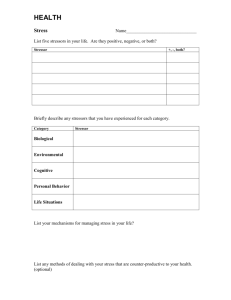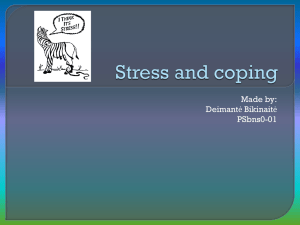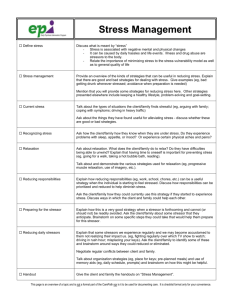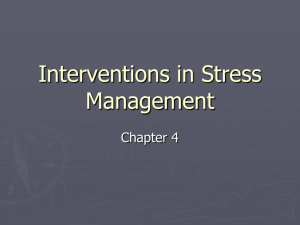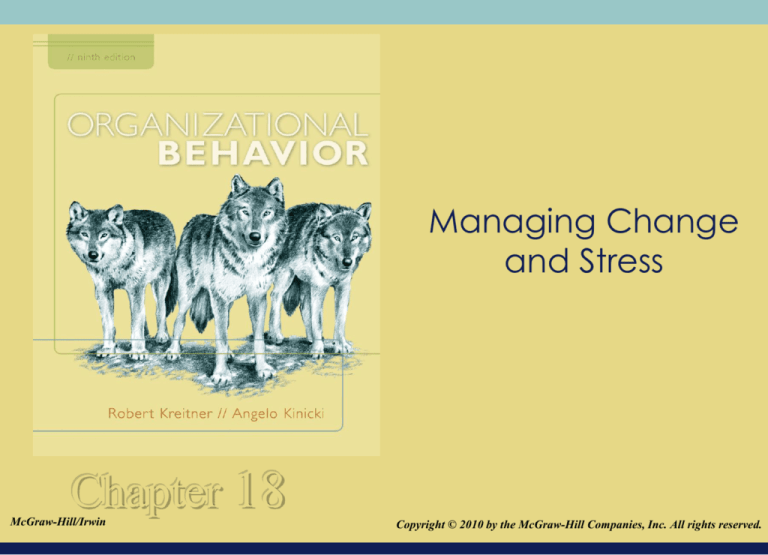
Managing Change
and Stress
Chapter 18
McGraw-Hill/Irwin
Copyright © 2010 by the McGraw-Hill Companies, Inc. All rights reserved.
© 2008The McGraw-Hill Companies, Inc. All rights reserved.
Ch. 18 Learning Objectives
1. Discuss the external and internal forces that create
the need for organizational change.
2. Describe Lewin’s change model and the systems
model of change.
3. Discuss Kotter’s eight steps for leading
organizational change.
4. Define organizational development and explain the
OD process.
5. Explain the dynamic model of resistance to change.
18-2
Ch. 18 Learning Objectives
6. Discuss the key recipient and change agent
characteristics that cause resistance to change.
7. Identify alternative strategies for overcoming
resistance to change.
8. Define the term stress, and describe the model of
occupational stress.
9. Discuss the stress moderators of social support,
hardiness, and Type A behavior.
10. Discuss employee assistance programs (EAPs) and a
holistic approach toward stress reduction.
18-3
Forces of Change
External
Demographic Characteristics
Technological Advancements
Shareholder, Customer, and Market
Changes
Social and Political Pressures
The Need for Change
Internal
Human Resource Problem/Prospects
Managerial Behavior/Decisions
18-4
Forces that Stimulate
Change in Organizations
External forces that
stimulate change:
• Demographic
characteristics
• Technological
advancements
• Shareholder,
Customer, and
Market changes
• Social and political
pressures
18-5
Forces that Stimulate
Change in Organizations
Internal forces that
stimulate change:
• Human resource
problems
• High turnover
• Perceptions of unfair
treatment
• Managerial
Behavior/Decisions
• Excessive interpersonal
conflict
• Inadequate direction or
support
18-6
Types of Organizational Change
Adaptive
Change
Innovative
Change
Reintroducing
a familiar
practice
Introducing a
practice new
to the
organization
Low
Radically
Innovative
Change
Introducing a
practice new
to the industry
High
Degree of complexity,
cost, and uncertainty
Potential for
resistance to change
18-7
Lewin’s Change Model
• Unfreezing
• Creates the motivation to change
• Benchmarking Data
• Financial data, emerging trends
Changing
– Provides new information, new behavioral
models, or new ways of looking at things
Refreezing
– Helps employees integrate the changed behavior or
attitude into their normal way of doing things
18-8
A Systems Model of Change
Target Elements of Change
Organizing
Arrangements
Inputs
Outputs
Internal
Strengths
Strategy
Goals
People
Weaknesses
External
Social
Factors
Internal
Organizational
level
Opportunities
Department/
group level
Threats
Individual level
Methods
18-9
Kotter’s Eight Steps for Leading
Organizational Change
Step
Table 18-1
Description
1)
Establish a sense of
urgency
Unfreeze the organization by creating a compelling
reason for why change is needed
2)
Create the guiding
coalition
Create a cross-functional, cross-level group of people
with enough power to lead the change
3)
Develop a vision and
strategy
Create a vision and strategic plan to guide the
change process
4)
Communicate the
change-vision
Create and implement a communication strategy that
consistently communicates the new vision and
strategic plan
18-10
Kotter’s Eight Steps for Leading
Organizational Change
Step
Table 18-1
Description
5)
Empower broad-based
action
Eliminate barriers to change, use target elements of
change to transform the organization
6)
Generate short-term wins
Plan for and create short-term “wins” or
improvements
7)
Consolidate gains and
produce more change
The guiding coalition uses credibility from shortterms wins to create change. Additional people are
brought into the change process as change cascades
throughout the organization
8)
Anchor new approaches
in the culture
Reinforce the changes by highlighting connections
between new behaviors and processes and
organizational success
18-11
Organizational Development
Organizational
Development a
set of techniques or
tools that are used
to implement
organizational
change
18-12
How OD Works
18-13
Test Your Knowledge
Which of the following would be considered an effective
organization development approach?
a. A manager decides to move everyone’s office around for
“something different”
b. An HR department decides to restructure the performance
management process affecting every employee. They decide
not to bother top management during the decision process.
c. An experienced OD consultant reorganizes an American
company with great success. He plans on executing the same
plan in a Chinese company.
d. Top management and OD consultants work together to
create a more participative decision-making culture.
18-14
Why People Resist Change in the
Workplace
1) An individuals’
predisposition
toward change
2) Surprise and fear of
the unknown
3) Climate of mistrust
4) Fear of failure
5) Loss of status and/or
job security
18-15
Why People Resist Change in the
Workplace
6) Peer pressure
7) Disruption of cultural
traditions and/or group
relationships
8) Personality conflicts
9) Lack of tact and/or poor
timing
10) Nonreinforcing reward
systems
11) Past success
18-16
Causes of Resistance to Change
18-17
Overcoming Resistance to Change
Approach
Commonly Used in
Situations Where:
Advantages
Drawbacks
Education and
Communication
There is a lack of
information or
inaccurate
information &
analysis
Once persuaded,
people will often
help with
implementation of
change
Can be very time
consuming if lots of
people are involved
Participation and
Involvement
The initiators do not
have all the
information they
need to design the
change & others have
considerable power
to resist
People who
participate will be
committed to the
implementation of
change
Can be very time
consuming if
participators design
an inappropriate
change
Facilitation and Support
People are resisting
because of
adjustment problems
No other approach
works as well with
adjustment problems
Can be very time
consuming,
expensive and still
fail
18-18
Table 18-3
Overcoming Resistance to Change
Approach
Commonly Used in
Situations Where:
Advantages
Drawbacks
Negotiation and
Agreement
Someone or some
group will clearly
lose out in a change
and where that
group has
considerable power
to resist
Sometimes it is a
relatively easy way
to avoid major
change
Can be too expensive
in may cases if it
alerts other to
negotiate for
compliance
Manipulation and
Co-optation
Other tactics will not
work or are too
expensive
It can be relatively
quick and
inexpensive
Can lead to future
problems if people
feel manipulated
Explicit and Implicit
Coercion
Speed is essential
and where the
change initiators
possess considerable
power
It is speedy and can
overcome any kind
of resistance
Can be very risky ad
leave people mad at
the initiators
18-19
Your Experience
For the following questions use this scale:
1=Strongly Disagree, 3= Neutral, 5=Strongly Agree
1. I feel stress in my life.
2. I feel stress from family
obligations/relations.
3. School is a source of stress in my life.
4. My job is causes me to feel stressed.
5. I feel stress from world events.
18-20
Stress
Stress behavioral, physical, or
psychological response to
stressors
• Stress is not merely
nervous tension
• Stress can have positive
consequences
• Stress is not something to
be avoided
• The complete absence of
stress is death
• Stress is inevitable
18-21
Occupational Stress
Potential Stressors
Outcomes
Psychological/
Attitudinal
Individual Level
Group Level
Cognitive
Appraisal
Coping
Strategies
Behavioral
Moderators
Organizational Level
Cognitive
Extraorganizational
Level
Physical Stress
18-22
Stressors
Cognitive Appraisal of Stressors
• Primary Appraisal determining whether a stressor is
irrelevant, positive, or stressful
• Secondary Appraisal assessing what might and can be
done to reduce stress
Coping Strategies
• Control
• Escape
• Symptom management
18-23
Moderators of Occupational Stress
Moderators
variables that cause the relationships
between stressors, perceived stress and outcomes to
be weaker for some and stronger for others
What kinds of things may moderate or affect the
impact of stress?
18-24
Social Support
Social Support
amount of helpfulness derived
from social relationships
Hardiness
personality characteristic
that neutralizes stress
18-25
Type A Behavior Pattern
Type A Behavior
Pattern
aggressively involved
in a chronic,
determined struggle
to accomplish more
in less time
18-26
Table 18-3
Type A Characteristics
1) Hurried speech; explosive accentuation of key words
2) Tendency to walk, move, or eat rapidly
3) Constant impatience with rate at which most events
take place
4) Strong preference for thinking of or doing two or
more things at once
5) Tendency to turn conversations around to personally
meaningful subjects or themes
18-27
Table 18-3
Type A Characteristics
6) Tendency to interrupt while others are speaking to
maker your point or to complete their thought in
your own words.
7) Guilt feelings during periods of relaxation or leisure
time.
8) Tendency to be oblivious to surroundings during
daily activities
9) Greater concern for things worth having than with
things worth being.
18-28
Table 18-3
Type A Characteristics
10) Tendency to schedule more and more in less and
less time; a chronic sense of time urgency
11) Feelings of competition rather than compassion
when faced with another Type A person
12) Development of nervous tics or characteristic
gestures
13) A firm belief that success is due to the ability to get
things done faster than the other guy
14) A tendency to view and evaluate personal activities
and the activities of other people in terms of
“numbers”
18-29
Table 18-4
Stress-Reduction Techniques
Technique
Description
1)
Muscle Relaxation
Uses slow deep breathing and systematic
muscle tension reduction.
2)
Biofeedback
A machine is used to train people to detect
muscular tension; muscle relaxation is then
used to alleviate this symptom of stress
3)
Meditation
The relaxation response is activated by
redirecting one’s thoughts away from
oneself; a four-step procedure is used to
attain passive stress-free state of mind
4)
Cognitive Restructuring
Irrational or maladaptive thoughts are
identified and replaced with those that are
rational or logical.
5)
Holistic wellness
An interdisciplinary approach that goes
beyond stress reduction by advocating that
people strive for personal wellness in all 18-30
aspects of their lives
Test Your Knowledge
Lynn feels anxiety and stress everyday before
going to work in anticipation of her daily
tasks. She wants to find a way to reduce her
stress that she can do alone and that is
inexpensive. Which stress reduction
technique would be best for Lynn?
a.
b.
c.
d.
Biofeedback
Muscle relaxation
Meditation
Cognitive restructuring
18-31
Managing Change
and Stress
Supplemental
Slides
Chapter 18
© 2008The McGraw-Hill Companies, Inc. All rights reserved.
Health Care Collapse
% of GDP spent on
health care
19% of US employers
are planning to drop
their health care
coverage
US – 17.6%
4% already
have
UK – 7.6%
38% question
their ability to
in the long term
Source: Workforce Management, 4/20/2009
Over 50% do not
support current
system
Need a
viable
alternative
18-33
Change Agents
Have to have power to
advocate
a new
direction
hire
promote
Source: Welch, J. & Welch, S. What Change Agents are Made of, BusinessWeek, 10/20/08
reward
18-34
Change Agents
But must be leaders
who have
a vision of
future
the courage
to bet their
careers
Source: Welch, J. & Welch, S. What Change Agents are Made of, BusinessWeek, 10/20/08
a core set of
fervent
supports
18-35
Organizational Decline
Keep
Building
Invest in
the future
Communicate
Intensively
Have regular
sessions to
plan and
discuss “what
if” scenarios
Evaluate
Your
Customers
Identify
your highrisk
customers
No Across
the Board
Cuts
Align
spending
cuts with
your
strategy
18-36
Source: Charan, R. Ram’s Rules, Fortune, February 18, 2008
Personal Change Management
When facing change you may choose to:
•Embrace it as an opportunity to
grow and improve
•Try to ignore it
•Fight it
•Become angry and upset
Source: Evenson, R. Prepare yourself: Like it or not, change is coming! Supervision, February, 2009, pg. 8-11
18-37
Phases of Change
1. Denial
• trouble accepting the inevitable
2. Sadness
• realization of the things you’ll miss
3. Resistance
• sense of turmoil
Source: Evenson, R. Prepare yourself: Like it or not, change is coming! Supervision, February, 2009, pg. 8-11
18-38
Phases of Change (con’t)
4. Exploration
• begin to research the new reality to
make yourself more comfortable
5. Acceptance
• consider the positive aspects of
the change
Source: Evenson, R. Prepare yourself: Like it or not, change is coming! Supervision, February, 2009, pg. 8-11
18-39
Phases of Change (con’t)
Remain Objective
• Knowing these phases helps you keep perspective, talk to
others if you feel yourself backsliding into earlier stages
Stay Positive
• Focus on the impact on others and trying to help them
Stay Accountable for Outcomes
• Focus on your work, prioritize, problem solve
Source: Evenson, R. Prepare yourself: Like it or not, change is coming! Supervision, February, 2009, pg. 8-11
18-40
Money – Top Stressor
Women were most likely to report feeling stress about
finances (e.g., money, the economy, health problems,
housing costs).
47% stay their stress has increased since last year and
many reported stress-related physical and emotional
symptoms.
48% admit overeating or eating unhealthy foods to
manage stress; 18% report drinking and 16% report
smoking.
% who reported exercising or walking to manage stress
was down from 50% last year to 47% this year.
Source: Martin, S. Money is the top stressor for Americans, Monitor on Psychology, December 2008.
18-41
Discussion Questions
What strategies do you use to manage stress?
Are some more effective than others?
What are effective ways organizations can handle
stress in an economic downturn?
What are ineffective actions organizations might
take?
18-42
Time Saving Ideas
Use Auto-reply tool to
let people know when
you will be returning
emails
Use your life and work
purpose to be a beacon
for what you do and
how you spend your
time
Set aside 1 hour a day
for administrivia
Come in an extra halfhour early before
others arrive to get
tasks done that require
full attention
Source: McGregor, J. Making Every Hour Count, BusinessWeek, September 2008
18-43
Video Cases
Louisville Slugger-Hillerich & Bradsby
18-44
Management in the Movies
Gung Ho – “Not a good beginning”
It is the first day for the new Assan Motors employees. The
employees are happy to be working again. Hunt Stevenson
(Michael Keaton) has accepted the job of liaison between the
Japanese management and the American workers. The plant
manager, Kazihiro (Gedde Watanabe) is beginning the day with
exercises and a speech about company loyalty.
Questions
• Could Kazihiro have done anything differently to improve the
transition?
• Are exercises and uniforms a necessary part of running a
manufacturing facility?
• Was Stevenson effective in leading the workers to change?
18-45
Tips for Exercising Regularly
Exercise early
Stay close to home
Combine work,
family, and exercise
time
Mix exercise into
your day
Be committed
Source: Doctor’s Orders: Ways to Work Exercise Into a Busy Day; Health Journal at Wall Street Journal, 1/9/07
18-46
The Process Audit
To ensure longterm sustainability
through effective
business processes,
organizations need:
1. Process Enablers
2. Enterprise
Capabilities
Source: The Process Audit, Hammer, M. (2007, April). Harvard Business Review
18-47
The Process Audit
Process Enablers
Design
Performers
Owner
Infrastructure
Metrics
Enterprise Capabilities
Leadership
Culture
Expertise
Governance
Source: The Process Audit, Hammer, M. (2007, April). Harvard Business Review
18-48
In Good Company Movie Clip
What factors are present in this scene that
would prevent someone from presenting an
alternative point of view?
What risks did Dan Foreman take when he
stood up to Teddy K?
If your employee was the one to stand up, how
would you respond?
What do you think the impact of the
dissention will be on Teddy K? the employees?
18-49
Change Approaches
Economic focus: Firms value financial return to
stockholders using downsizing, layoffs,
restructuring.
•Al “Chainsaw” Dunlap - Scott Paper,
Sunbeam
Focus on organizational capabilities: Firms value
corporate culture, human capabilities, information
feedback, measurements.
•Denny’s approach to achieving courtordered change
18-50
Reclaim Your Job
Dealing with Multiple Demands
• Establish your goals and priorities and stick to them
• Say “no” when you have to in order to stay on track
Developing Resources
• Work within your limits but make your resources have
big impact
• This will lay the foundation for acquiring future
resources
Exploiting Alternatives
• Don’t limit your choices
• Stay open to the variety of ways to pursue strategic
objectives
18-51
Smoking Affects Organizational Costs
and Productivity
Smoking caused more than $157 billion in
annual health-related losses, according to
CDC
The annual productivity cost is $1,760 per
smoker in the US due to worker’s absence
because of smoking-related illness or death.
Smokers who work in smoke-free
environment are more likely to quit smoking.
18-52
Rational Approach to Change
Assumptions in a rational approach:
Explanations and information should be carefully
considered by recipients
The benefits of change will be clear to them
They should be easily persuaded to hold a positive
attitude about change
Changing the way employees think about change will
change the way they feel about it
Should have a domino effect on the person’s entire
approach to change
18-53
Emotional Approach to Change
An emotional approach:
Cognition and feelings are closely interrelated
Sometimes cognition and feelings are in conflict
When in conflict, affecting emotions will lead to
cognitive facets to align with emotional ones
Ignoring the emotional aspect of change and focusing
only on rational will keep firm employees’ objection
to the change
18-54
Communicating for Emotion
Use:
• Pictures
• Colors
• Music
• Taste
• Smell
• Atmosphere
• Pain
• Sensation
• Songs
Emotional Processes
Include:
• Happiness
• Anger
• Irritation
• Sadness
• Love
• Fear
• Relief
18-55
Methods for Affecting Emotions
Managers should consider:
1)
2)
3)
4)
5)
The key messages regarding change
How the message is packaged
Characteristics of change leaders
Interaction of change leaders and employees
Setting in which interaction takes place
18-56
Key Messages Regarding Change
To appeal for change;
use words with
emotional
connotation:
• Danger
• Loss
• Unpleasantness
• Risk
To depict
organization’s future;
use words assoc. with
optimism:
• Comfortable
• Convenient
• Success
• Progress
• Pleasure
• Relief
18-57
Packaging the Message
Messages should
include:
• Pictures
• Slogans
• Music
• Color
• Humor
18-58
Characteristics of Change Leaders
Change Leaders Should Be:
• Moral and adhere to ethical
standards
• Competent
• Knowledgeable
• Open
• Concerned
• Perceived as motivated by
truth; not having vested
interest in change
18-59
Interaction with Employees
Change Leaders Should:
• Treat their subordinates
fairly and honestly
• Let them voice their
concerns or objects
• Listen to their needs
• Sympathize with them
18-60
Employee Engagement & Organizational
Change
Strategic Vision
Business Success
Model
Values
Initiatives
Stretch Goals
Individual Change
Commitments
Company
Level
Strategic Vision
Business Success
Model
Values
Initiatives
Stretch Goals
Individual Change
Commitments
Manager
Teams Level
Strategic Vision
Business Success
Model
Values
Initiatives
Stretch Goals
Individual Change
Commitments
Managers to
Individuals Level
18-61
A Model of Burnout
Job &
organizational
stressors
Personal
stressors
Emotional exhaustion
Depersonalization
Attitudinal &
behavioral
symptoms of
burnout
Feeling a lack of
Personal accomplishment
18-62
A Flow Model of Mechanisms of Social
Support
Potential Stressful Event
Support
Perceived
but
not
used
and
used
Perceived availability of
support resources
Support not
perceived
Purpose of support
Engage support
Effect of social support
on reducing stress and
stress outcomes
18-63
A Model of the Coping Process
Situational
factors
Control
Cognitive
appraisal
of stressor
Coping
Strategies
Escape
Symptom
management
Personal
factors
Harmful?
Threatening?
Challenging?
18-64
Mental Health Benefits
1 in 5 Americans will suffer from a mental disorder in
the course of one year
Approximately 18.8 million American adults suffer
from depression
Treatments costs run about $80 billion a year
Mental illness causes more disability and loss of life
than any other illness except heart disease
Loss in productivity as a result is estimated at $80
billion a year
Cost-effective treatments now exist for mental illness
18-65
Obese America
Australia
Britain
One decade ago
France
Most recent obesity
rate
Japan
U.S.
0%
10%
20%
30%
18-66
Conclusion
Questions for discussion
18-67

